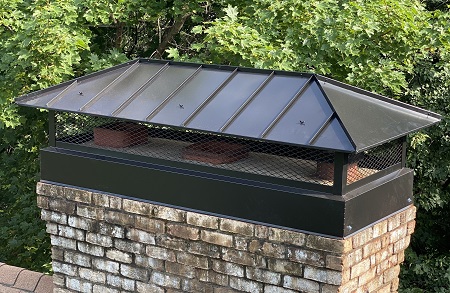When selecting places to construct nests, squirrels typically look for secluded areas off the ground with plenty of cover. The natural location for a squirrel nest is between tree branches or in a hollow tree.
Signs of Squirrels in Chimneys
The top of the chimney provides easy access to warmth and shelter for a squirrel nest. While squirrels rarely infest chimneys themselves, the rodents may nest in metal chimney boxes. If the flue is made of stone or brick, a squirrel can climb down and build a more secure nest. If the flue is made of slick metal, the squirrel can fall and get stuck in the fireplace or on the damper.
Residents may hear chittering, fighting, or scratching at all hours of the day, smell squirrel droppings, and even see the pests running loose inside the home. If you hear loud noises at night, you probably have a raccoon in the chimney.
Squirrel Problems in the Chimney
Squirrels in the chimney are a fire hazard. Squirrels like to build nests in warm and protected areas, and chimneys provide an ideal location. They may bring in twigs, leaves, and other materials to construct their nests, which can block the chimney and disrupt proper airflow. Squirrels may accidentally fall or get stuck inside the chimney flue. Their presence can restrict the flow of smoke and gases, leading to poor ventilation and an increased risk of carbon monoxide buildup in the house.
Squirrels have teeth that continue to grow throughout their lives, so they constantly need to gnaw on hard objects to wear them down. This chewing behavior can damage the structure of the chimney, such as cracking the flue tiles or damaging chimney caps, which can eventually lead to leaking or structural issues.
What NOT to do to Get Squirrel out of Chimney and Fireplace
Do not attempt to “smoke out” squirrels. Opening the fireplace can provide an easy escape hatch for a trapped squirrel. A stuck squirrel cannot climb out and escape the smoke and heat. Nesting materials can catch on fire. Baby squirrels cannot escape the fire.
Do not open the damper and try to catch the squirrel. Squirrels are agile and fast. They can elude a snare pole handled by the most skilled pest professionals.
Save your money; do not try any squirrel repellents. You will have to open the fire place to apply them. A trapped squirrel cannot climb out. And generally, wildlife repellents are not effective control measures.
How to Get Rid of Squirrels in Chimney

Dropping a thick rope down your chimney is one of the easiest ways to get rid of a trapped squirrel. Squirrels are excellent climbers and use the rope as an escape route. Your chimney will need a new chimney cap to prevent future animal infestations.
If the squirrel is not stuck inside the flue, the process is more involved.
A live trap used in conjunction with an excluder is the best way to get rid of squirrels. Once the squirrels are removed, proper exclusion devices like a chimney cap need to be installed. If a female squirrel establishes a nest, baby squirrels will need to be safely moved. That can be tricky if the squirrel nest is at the bottom of the chimney.
Learn more about squirrel removal.
Get them out.
Keep them out.®
Experiencing a wildlife or pest issue? We can help! Complete this form and your local Critter Control® office will contact you to assist.
- How to Get Rid of Squirrels
- Squirrels Entering Homes
- Squirrels in Attics
- Squirrels on Roofs & in Soffits
- Squirrels in Walls
- Squirrels in Ventilation
- Squirrels in Gutters
- Squirrels in Crawl Spaces
- Squirrels in Yards or Gardens
- Squirrels in Trees
- Squirrels Digging Holes in the Ground
- How to Identify Squirrel Sounds
- Squirrel Tracks
- Squirrel Droppings
- Squirrel Trapping
- Squirrel Repellents & Deterrents
- Squirrel Appearance & Identification
- Species & Types of Squirrels
- Squirrel Life Cycle
- Baby Squirrels
- Squirrel Nest
- Dead Squirrels
- Squirrel Diet
- Diseases That Squirrels Carry
- Rabid Squirrels
- Do Squirrels Hibernate?
- Gray Squirrels
- Do Squirrels Bite?
- Squirrel Damage to Your House
- Squirrels vs. Rats
- Squirrels vs. Chipmunks